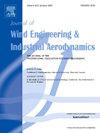Comparative analysis of crosswind influence on aerodynamic characteristics of superconducting and normal-conducting high-speed maglev trains
IF 4.9
2区 工程技术
Q1 ENGINEERING, CIVIL
Journal of Wind Engineering and Industrial Aerodynamics
Pub Date : 2025-07-31
DOI:10.1016/j.jweia.2025.106182
引用次数: 0
Abstract
The development and construction of high-speed maglev systems with design speeds of up to 600 km/h have been initiated worldwide for faster and safer travel. Maglev train systems are divided into normal conducting maglev trains (NCMTs) and superconducting maglev trains (SMTs). NCMT operates on track beams, whereas the SMT operates in track slots, leading to substantial differences in the aerodynamic properties of high-speed maglev trains under crosswind conditions. This study investigated the flow field characteristics around maglev trains with different levitation methods under crosswind conditions and compared the differences in the flow field characteristics between the two levitation methods. The results showed that, as the crosswind speed increases, the crosswind effect intensifies, leading to a deterioration in the train flow filed, manifested as increased flow field asymmetry and enhanced vortex structures around the train. Compared to the NCMT, the crosswind exerts a relatively minor influence on vortex development in an SMT. The NCMT has more significant aerodynamic and slipstream effects than the SMT because of its track structure, and the SMT has less side force than the NCMT.
侧风对超导与正导高速磁悬浮列车气动特性影响的对比分析
设计速度高达600公里/小时的高速磁悬浮系统的开发和建设已经在世界范围内启动,以实现更快、更安全的旅行。磁浮列车系统分为常导磁浮列车(NCMTs)和超导磁浮列车(SMTs)。NCMT运行在轨道梁上,而SMT运行在轨道槽上,导致侧风条件下高速磁悬浮列车的空气动力学特性存在实质性差异。研究了侧风条件下不同悬浮方式的磁悬浮列车周围流场特性,比较了两种悬浮方式流场特性的差异。结果表明:随着侧风风速的增大,侧风效应加剧,导致列车流场恶化,表现为流场不对称性增加,列车周围涡结构增强;与NCMT相比,侧风对SMT涡发展的影响相对较小。由于NCMT的轨道结构,其气动和滑流效应比SMT更显著,而SMT的侧力比NCMT小。
本文章由计算机程序翻译,如有差异,请以英文原文为准。
求助全文
约1分钟内获得全文
求助全文
来源期刊
CiteScore
8.90
自引率
22.90%
发文量
306
审稿时长
4.4 months
期刊介绍:
The objective of the journal is to provide a means for the publication and interchange of information, on an international basis, on all those aspects of wind engineering that are included in the activities of the International Association for Wind Engineering http://www.iawe.org/. These are: social and economic impact of wind effects; wind characteristics and structure, local wind environments, wind loads and structural response, diffusion, pollutant dispersion and matter transport, wind effects on building heat loss and ventilation, wind effects on transport systems, aerodynamic aspects of wind energy generation, and codification of wind effects.
Papers on these subjects describing full-scale measurements, wind-tunnel simulation studies, computational or theoretical methods are published, as well as papers dealing with the development of techniques and apparatus for wind engineering experiments.

 求助内容:
求助内容: 应助结果提醒方式:
应助结果提醒方式:


